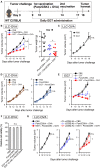Anti-oxidative Amino Acid L-ergothioneine Modulates the Tumor Microenvironment to Facilitate Adjuvant Vaccine Immunotherapy
- PMID: 31019508
- PMCID: PMC6458301
- DOI: 10.3389/fimmu.2019.00671
Anti-oxidative Amino Acid L-ergothioneine Modulates the Tumor Microenvironment to Facilitate Adjuvant Vaccine Immunotherapy
Abstract
Cancer vaccines consist of a tumor-associated antigen (TAA) and adjuvant. These vaccines induce and activate proliferation of TAA-specific cytotoxic T lymphocytes (CTLs), suppressing tumor growth. The therapeutic efficacy of TAA-specific CTLs depends on the properties of tumor microenvironment. The environments make immunosuppressive by function of regulatory T cells and tumor-associated myeloid cells; thus, regulation of these cells is important for successful cancer immunotherapy. We report here that L-ergothioneine (EGT) with the adjuvant Toll-like receptor 2 (TLR2) ligand modulated suppressive microenvironments to be immune-enhancing. EGT did not augment DC-mediated CTL priming or affect CTL activation in draining lymph node and spleen. However, EGT decreased the immuno-suppressive function of tumor-associated macrophages (TAMs). TLR2 stimulation accompanied with EGT administration downregulated expression of PD-L1, CSF-1R, arginase-1, FAS ligand, and TRAIL in TAMs, reflecting reduction of CTL suppression. An anti-oxidative thiol-thione residue of EGT was essential to dampening CTL suppression. The effect was specific to the thiol-thione residue of EGT because no effect was observed with another anti-oxidant N-acetyl-L-cysteine (NAC). A CTL-suppressive environment made by TLR2 is relieved to be improved by the addition of EGT, which may ameliorate the efficacy of vaccine immunotherapy.
Keywords: L-ergothioneine; cytotoxic T lymphocyte; toll-like receptor; tumor microenvironment; tumor-associated macrophage.
Figures







Similar articles
-
A TLR3-Specific Adjuvant Relieves Innate Resistance to PD-L1 Blockade without Cytokine Toxicity in Tumor Vaccine Immunotherapy.Cell Rep. 2017 May 30;19(9):1874-1887. doi: 10.1016/j.celrep.2017.05.015. Cell Rep. 2017. PMID: 28564605
-
Novel TLR2-binding adjuvant induces enhanced T cell responses and tumor eradication.J Immunother Cancer. 2018 Dec 12;6(1):146. doi: 10.1186/s40425-018-0455-2. J Immunother Cancer. 2018. PMID: 30541631 Free PMC article.
-
Domatinostat favors the immunotherapy response by modulating the tumor immune microenvironment (TIME).J Immunother Cancer. 2019 Nov 8;7(1):294. doi: 10.1186/s40425-019-0745-3. J Immunother Cancer. 2019. PMID: 31703604 Free PMC article.
-
CD8+ cytotoxic T lymphocytes in cancer immunotherapy: A review.J Cell Physiol. 2019 Jun;234(6):8509-8521. doi: 10.1002/jcp.27782. Epub 2018 Nov 22. J Cell Physiol. 2019. PMID: 30520029 Review.
-
Therapeutic gene modified cell based cancer vaccines.Gene. 2013 Aug 10;525(2):200-7. doi: 10.1016/j.gene.2013.03.056. Epub 2013 Apr 6. Gene. 2013. PMID: 23566846 Review.
Cited by
-
The biology of ergothioneine, an antioxidant nutraceutical.Nutr Res Rev. 2020 Dec;33(2):190-217. doi: 10.1017/S0954422419000301. Epub 2020 Feb 13. Nutr Res Rev. 2020. PMID: 32051057 Free PMC article. Review.
-
Gemcitabine-mediated depletion of immunosuppressive dendritic cells enhances the efficacy of therapeutic vaccination.Front Immunol. 2022 Oct 10;13:991311. doi: 10.3389/fimmu.2022.991311. eCollection 2022. Front Immunol. 2022. PMID: 36300124 Free PMC article.
-
Orchestration of Tumor-Associated Macrophages in the Tumor Cell-Macrophage-CD8+ T Cell Loop for Cancer Immunotherapy.Int J Biol Sci. 2025 Jun 12;21(9):4098-4116. doi: 10.7150/ijbs.115932. eCollection 2025. Int J Biol Sci. 2025. PMID: 40607254 Free PMC article. Review.
-
Could Ergothioneine Aid in the Treatment of Coronavirus Patients?Antioxidants (Basel). 2020 Jul 7;9(7):595. doi: 10.3390/antiox9070595. Antioxidants (Basel). 2020. PMID: 32646061 Free PMC article. Review.
-
l-Ergothioneine Exhibits Protective Effects against Dextran Sulfate Sodium-Induced Colitis in Mice.ACS Omega. 2022 Jun 14;7(25):21554-21565. doi: 10.1021/acsomega.2c01350. eCollection 2022 Jun 28. ACS Omega. 2022. PMID: 35785312 Free PMC article.
References
-
- Ugel S, Mandruzzato S, Bronte V, Ugel S, De Sanctis F, Mandruzzato S, et al. Tumor-induced myeloid deviation : when myeloid-derived suppressor cells meet tumor- associated macrophages Find the latest version : tumor-induced myeloid deviation : when myeloid-derived suppressor cells meet tumor-associated macrophages. J Clin Invest. (2015) 125:3365–76. 10.1172/JCI80006.The - DOI - PMC - PubMed
Publication types
MeSH terms
Substances
LinkOut - more resources
Full Text Sources
Other Literature Sources
Medical
Research Materials
Miscellaneous

